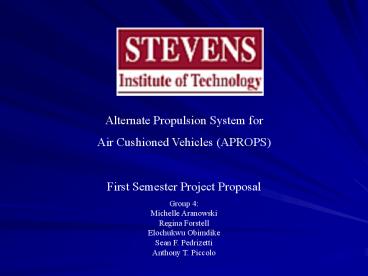Alternate Propulsion System for - PowerPoint PPT Presentation
1 / 16
Title:
Alternate Propulsion System for
Description:
Michelle Aranowski. Regina Forstell. Elochukwu Obimdike. Sean F. Pedrizetti. Anthony T. Piccolo ... mud flats, marsh, dry sand, and wet sand. 8% slope. Approach ... – PowerPoint PPT presentation
Number of Views:197
Avg rating:3.0/5.0
Title: Alternate Propulsion System for
1
Alternate Propulsion System for Air Cushioned
Vehicles (APROPS) First Semester Project
Proposal Group 4 Michelle Aranowski Regina
Forstell Elochukwu Obimdike Sean F.
Pedrizetti Anthony T. Piccolo
2
- Objective
- to develop an alternate propulsion system
(APROPS) to replace the current air screw system
that is currently employed on the US Navy Landing
Craft Air Cushion (LCAC) - the application of a new propulsion system for
the Joint Surface Assault Connector (JSAC), which
is currently in development as a replacement to
the LCAC
3
Technical Background
- ACV or Hover Crafts were first developed in
Britain in 1959 - Developed for the military as ship-to-shore
transports - The unique amphibious qualities of the ACV enable
it to land on 70 of the worlds shore line - The US currently has had a fleet of Landing Craft
Air Cushion (LCAC) for the past 20 years
4
Current Air Screw System Limitations
- High Power Requirements
- weight of the ACV and payload
- size of Air Screw
- Structural Vibrations
- obstruction of the air flow path
- obstructed mainly by cargo
5
Joint Surface Assault Connector (JSAC)
- The US military is currently looking for a new
ship-to-shore amphibious transport vehicle - The will replace the LCAC that is currently in
operation - The JSAC will be required to carry a larger
payload than previous ACV - A new propulsion system is needed
6
Function Flow Diagram
- Assumption vehicle starts on ship
- 1. Getting off Ship
- 1a Prep Craft
- loading Crew/Payload
- starting Primary Engines
- power up controls
- unplugging from ship
- starting on-ship propulsion system
- 1b Move off Ship
- exit the ship in reverse
7
Function Flow Diagram
- 2. Ship to Surf Zone
- 2a Switch to over water propulsion
- disengage on-ship propulsion system
- engage over water propulsion system
- 2b Move over Water
- maintain speed in specified conditions
- maintain maneuverability
8
Function Flow Diagram
- 3. Over Surf Zone
- 3a Switch to Surf Zone propulsion
- disengage over water propulsion system
- engage surf zone propulsion system
- 3b Move over off shore bar
- get to Bar
- negotiate obstacles
- mover past Bar
- 3c Move through Surf Zone
- get to surf zone
- compensate for increased wave height
- maintain maneuverability
9
Function Flow Diagram
- 4. Beach Landing
- 4a Switch to over land propulsion
- disengage surf zone propulsion system
- engage over land propulsion system
- 4b Move up beach
- 8 slope
- over range of terrain requirements
- maintain landing speed
- maintain maneuverability
- 4c Move over land to Landing Zone
- negotiate obstacles
- maintain landing speed
- maintain maneuverability
- stop at Landing Zone
- unload Payload
- check vehicle for return trip
10
Requirements Weight and Size
- Weight and Payload 224.5 long tons
- Including 89.3 long tons payload
- Craft Dimensions
- Cargo deck requirements
11
Requirements Performance over water and land
- Range
- 50 to 100 nautical mile over water
- 1 mile over land
- Speed
- 40 knots over water
- 10 knots over land
- Over Water Conditions
- Over Land Terrain
- mud flats, marsh, dry sand, and wet sand
- 8 slope
12
Approach
- Develop of either a hybrid propulsion system or a
standalone propulsion system - Hybrid Propulsion system
- Dual Propulsion system
- Separate over water system
- Separate over land system
- Standalone propulsion system
- Dual functioning system for over land and water
13
Approach and Trade-off analyses
- Brain Storm propulsion systems
- Run trade-off analyses for Hybrid system
- Run trade-off analyses for Standalone systems
Including high scoring Hybrid system - Trade off parameters
- Maneuverability, Effectiveness, Transition,
External Force Effect, Weight, Power, Size,
Maintenance, Life cycle, Deck arrangements, Well
deck storage, Cost, Noise/Vibration, Technology
risk, Ease of acquisition, and Manufacturability
14
Conceptual Design
- Standalone
- Jet Turbine
- Water Wheel
- Archimedes Screw
- Air Screw
- Strictly Land
- Wheels
- Tracks
- Winches w/ Grappling Hook
- Rollagons
- Strictly Water
- Water Screw
- Water Jet
15
Project Breakdown Structure
16
Questions?































